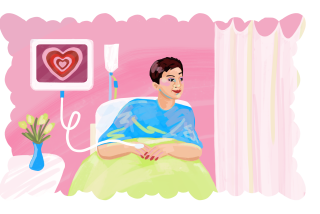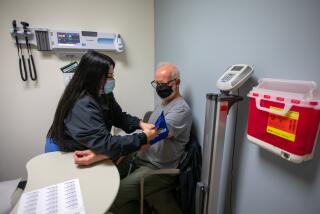My Turn: Back from the brink and feeling great
Have you ever wondered what it’s like running five miles on the trails of the Santa Monica Mountains less than three months after “dying” on the operating table? Have you ever thought how it might feel to walk around knowing that the physician’s assistant at the cardiac unit, a man with 17 years’ experience, refers to you as “the miracle”? Well, it is both amazing and surreal.
Though 50 years old, I am in great shape and the type of person who is virtually never sick. I play tennis once a week and run frequently. In the truest sense of the word, I was asymptomatic.
Here’s my story.
I returned from a holiday in England with a nagging cough and figured I needed some antibiotics. When I called my regular doctor, I was told he couldn’t see me for six weeks. I thus saw another physician and soon had a stethoscope put to my chest. I was told I had a murmur and needed to see a cardiologist ASAP.
I’ll never forget sitting smiling in front of the cardiologist, up on one of those doctor tables with that daffy paper laid across it … and then hearing I needed emergency open- heart surgery.
I felt myself go wobbly.
The aorta is the largest artery in the human body. Normally it is 3 centimeters wide. An aorta that expands to 5 cm requires surgery. Mine had inexplicably grown to well over three times its normal size. I later learned I had the largest thoracic aortic aneurysm (as this enlargement is called) that any of my healthcare professionals had ever seen.
Dr. Taro Yokoyama, a surgeon who specializes in performing high-risk operations, agreed to be my surgeon. The operation would take place at L.A.’s St. Vincent Medical Center.
My chest was cracked open. A cow’s valve replaced my old aortic valve. At this point, I should have happily moved toward recovery in the cardiac ICU. Instead, I began pouring blood through the drainage tubes. Two nurses were needed to stand on either side of me squeezing plasma bags so that blood entered my system as fast as it was leaving it.
It was decided that a second surgery needed to be performed immediately. My chest was cracked open again. A standard bypass surgery normally lasts four to five hours. In my case, another nine-hour surgery was performed. Unfortunately, the second surgery did not stop the bleeding either. I had been in surgery for 18 of the previous 19 hours. It was looking hopeless.
At this point, most wives hear, “I’m sorry, Mrs. Goldring, we did all we could.” However, my surgeon told the team to find more blood. A third nine-hour operation was performed.
I’m so grateful to the wonderful nurses and staff whose professionalism and compassion helped me survive my ordeal. And what can I say about a surgeon, 75 years old, who calmly persisted in a high-risk marathon like this one?
My son Ethan just went off to college in Santa Barbara. His dad was there to help him move. My daughter Megan, readying applications for the UC schools, just made a plan with her dad to go visit those universities. My youngest daughter, Molly, danced at the Thousand Oaks Civic Arts Plaza a few weeks back. One of the reasons she grinned so widely throughout her performance was because her dad was in the audience.
I sometimes see my wife, Lyn, looking over at me, smiling. She doesn’t need to say anything. We’re going on a date this weekend.
Before my surgeries, when people asked me how I was doing, I’d reply, “Life is good.” Looking at Lyn, my three kids and a fantastic community of friends, I now reply to that question, “Life is great!”
Goldring, a financial advisor, lives in Calabasas. He can be reached at [email protected].
My Turn is a forum for readers to recount an experience related to health or fitness. Submissions should be no more than 500 words. They are subject to editing and condensation and become the property of The Times. Please e-mail [email protected]. We read every essay but can’t respond to every writer.






